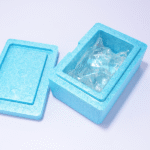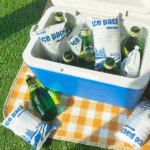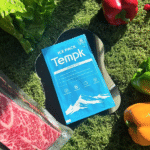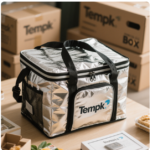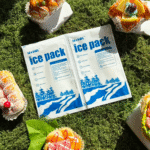Chapeau de pack de glace sec: Comment plafonner votre cargaison avec une confiance ultra-froide
L'expédition des produits surgelés ne devrait pas ressembler à un pari. UN Chapeau de pack de glace sec—Un Capulade moulé de Solid Co₂ - Ajoute un bouclier de –78 ° C au-dessus de votre charge, La température de réduction des pics de 65% et la coupe de détérioration prétend à moins de 12%. Dans les prochaines minutes, Vous apprendrez pourquoi ce simple «chapeau» surpasse les granulés en vrac, Comment le dimensionner, Et quoi 2025 étiquettes de sécurité que vous devez montrer au quai.

-
Qu'est-ce qu'un chapeau de pack de glace sec pour l'expédition et pourquoi l'utiliser?
-
Quelle taille de chapeau fonctionne le mieux pour la nourriture, biologique, ou combos de gel de pack de glace sec?
-
Comment faire nouveau 2025 Les règles IATA et OSHA affectent l'étiquetage et la ventilation?
-
Quelle séquence d'emballage maintient les marchandises congelées pendant 72 heures?
-
Quelles tendances technologiques redéfiniront les performances du chapeau de pack de glace sèche?
Qu'est-ce qu'un chapeau de pack de glace sec pour l'expédition?
Un chapeau de pack de glace sec est une dalle de glace sèche pré-formée qui niche sur des produits comme un couvercle, offrir un flux d'air stable –78 ° C vers le bas. Sa forme uniforme ralentit la sublimation de 30% contre les pastilles et empêche les «points chauds» froids qui fissurent l'emballage.
Contrairement aux feuilles plates, Les canaux de jante surélevés du chapeau sont des gaz vers les évents latéraux, Protéger les cartons délicats de la gorgée de l'explosion directe. Vous obtenez des charges plus propres, conditionnement plus léger, Et un empilement plus facile dans des refroidisseurs serrés.
Comment un chapeau de pack de glace sec améliore-t-il la prise thermique?
| Métrique de performance | Boulettes lâches | Chapeau de pack de glace sec | Impact pratique |
|---|---|---|---|
| Temps monte à –40 ° C | 18 H | 42 H | Tampon plus long pour les retards |
| Risque de rafale de gaz co₂ | Modéré | Faible | Moins d'événements de pression-alarme |
| Points de contact | 3–4 scoops | 1 placement | Lignes de pack-out plus rapides |
Dimensionner correctement votre chapeau de glace sec
Choisissez le poids du chapeau par durée de la voie et de l'empreinte de la boîte, Pas de supposition. Suivez la règle rapide: masse du chapeau = 0.4 × zone de base (kg) pour un transit de 48 heures à ≤ 30 ° C.
| Base de boîte (cm²) | Transit ≤24h | 24–48h | > 48h | Ce que cela signifie pour vous |
|---|---|---|---|---|
| 900 | 0.3 kg | 0.5 kg | 0.8 kg | Économise le poids du liquide de refroidissement sur les routes rapides |
| 1,600 | 0.6 kg | 1.0 kg | 1.4 kg | Coût équilibré & endurance |
| 2,400 | 0.9 kg | 1.4 kg | 2.0 kg + doublure | Tranquillité d'esprit sur des voies extrêmes |
Cas réel: Un exportateur de fruits de mer a adopté des chapeaux de pack de glace sec de 1 kg pour les vols de 36 heures et des palettes rejetées coupées de 6,2% à 1,7% tout en rasant 12% de réduction sur le liquide de refroidissement.
Comment emballez-vous avec un chapeau de pack de glace sec pour une prise maximale?
Suivez une méthode de superposition haut de gamme:
-
Chargez des produits à l'intérieur d'un expéditeur EPS ou VIP.
-
Ajouter un coussin d'espaceur pour créer des lacunes de flux d'air.
-
Positionner le chapeau de pack de glace sec à plat, rimer- L'air froid coulera naturellement.
-
Évacuer le couvercle: Quatre trous de 5 mm ou une bougie en mousse respirante.
-
Scellez la boîte avec du ruban renforcé et appliquez des étiquettes UN1845.
Pourquoi le placement supérieur compte: Co₂ Gas descend. Placer le chapeau sur le dessus garantit un refroidissement de type couverture et empêche les taches de gel qui se produisent lorsque les granulés sont assis à côté des cartons.
Sécurité des mains lors de la manipulation d'un chapeau de pack de glace sec
-
Portez des gants et des lunettes isolés. La surface de –78 ° C de la dalle provoque des gelures instantanées.
-
Utilisez un soulevé de pince- pas les doigts - pour éviter de laisser tomber le chapeau sur les bords du produit.
-
Limiter l'ouverture ouverte: Chaque minute à température ambiante brûle ~ 1% de la masse. Les chapeaux de scène durent.
Que sont les 2025 Règlements pour les chapeaux de pack de glace sec?
Les chapeaux de pack de glace sec tombent sous UN1845 «glace sèche» mais de nouveaux conseils ajoutent deux incontournables:
-
Identifiant de chapeau: Les forfaits doivent lire «Chapeau de pack de glace sec - ventilé».
-
Tag de poids QR: Les compagnies aériennes scannent maintenant un code montrant la masse initiale du chapeau pour le suivi du CO₂.
La non-conformité peut retarder l'exportation ou entraîner des amendes de 2K USD par palette. L'OSHA nécessite également des SOP de manipulation du chapeau dans les modules de formation à la salle du froid d'ici juillet 2025.
2025 Tendances façonnant l'innovation du chapeau de pack de glace sèche
-
Chapeaux en nid d'abeille: Les noyaux de treillis légers réduisent la masse de 20% avec un temps de maintien identique.
-
Jantes pcm-hybrides: Mélanger –30 ° C PCM dans la jante pour lisser le réchauffement de la vie.
-
Films de ventilation intelligents: Les membranes ouvrent à 1 psi, Couper le risque d'éclatement dans les conteneurs scellés.
Les analystes prédisent un 8.7 % CAGR pour la demande de chapeau de paquet de glace sèche à travers 2028, Poussé par la logistique de la thérapie cellulaire et les voies de gêne électronique plus longues.
Questions fréquemment posées
Combien de temps dure un chapeau de pack de glace sec?
Généralement 36 à 48 heures à 25 ° C ambiant; Ajouter des doublures pendant 72 heures sur les routes plus chaudes.
Puis-je réutiliser un chapeau de pack de glace sec?
Oui, s'il conserve au moins 70% de la masse d'origine et ne montre aucune fissure. Recharge dans un congélateur.
Est un chapeau plus sûr que les pastilles?
Oui - la surface plus fraîche signifie une libération de gaz plus lente et moins de co₂ dans les salles de pack.
Et si ma boîte a fait des conseils sur le côté?
La jante du chapeau tient la position, Empêcher les collisions qui pourraient écraser les cartons.
Principaux à retenir
-
UN Chapeau de pack de glace sec agit comme un couvercle congelé, prolonger le temps de gel et réduire le désordre.
-
Taille du chapeau par empreinte et durée de la voie; Utilisez la table pour des choix rapides.
-
Le placement des plans haut de gamme avec des couvercles ventilés empêche la construction de pression.
-
2025 Les règles exigent un nouvel étiquetage «chapeau» et des étiquettes de masse QR - Adate vos SOPS.
-
Les chapeaux en nid d'abeille plus légers et PCM augmenteront la durabilité et les performances.
Étapes suivantes
-
Télécharger la calculatrice de dimensionnement du chapeau Tempk composer des poids exacts.
-
Demandez des exemples de chapeaux Pour un test de simulation de voie - Results en 48 heures.
-
Réservez une consultation avec un ingénieur thermique tempk pour optimiser votre pack complet -.
À propos du tempk
Nous concevons des solutions avancées à la chaîne froide - de Chapeaux de paquet de glace sec et gels aux expéditeurs compatibles IoT. Nos plantes ISO13485 et cinq brevets Co₂-Hat gardent votre cargaison froide, conforme, et rentable.
Expédier plus intelligemment aujourd'hui -parler à tempk.
















